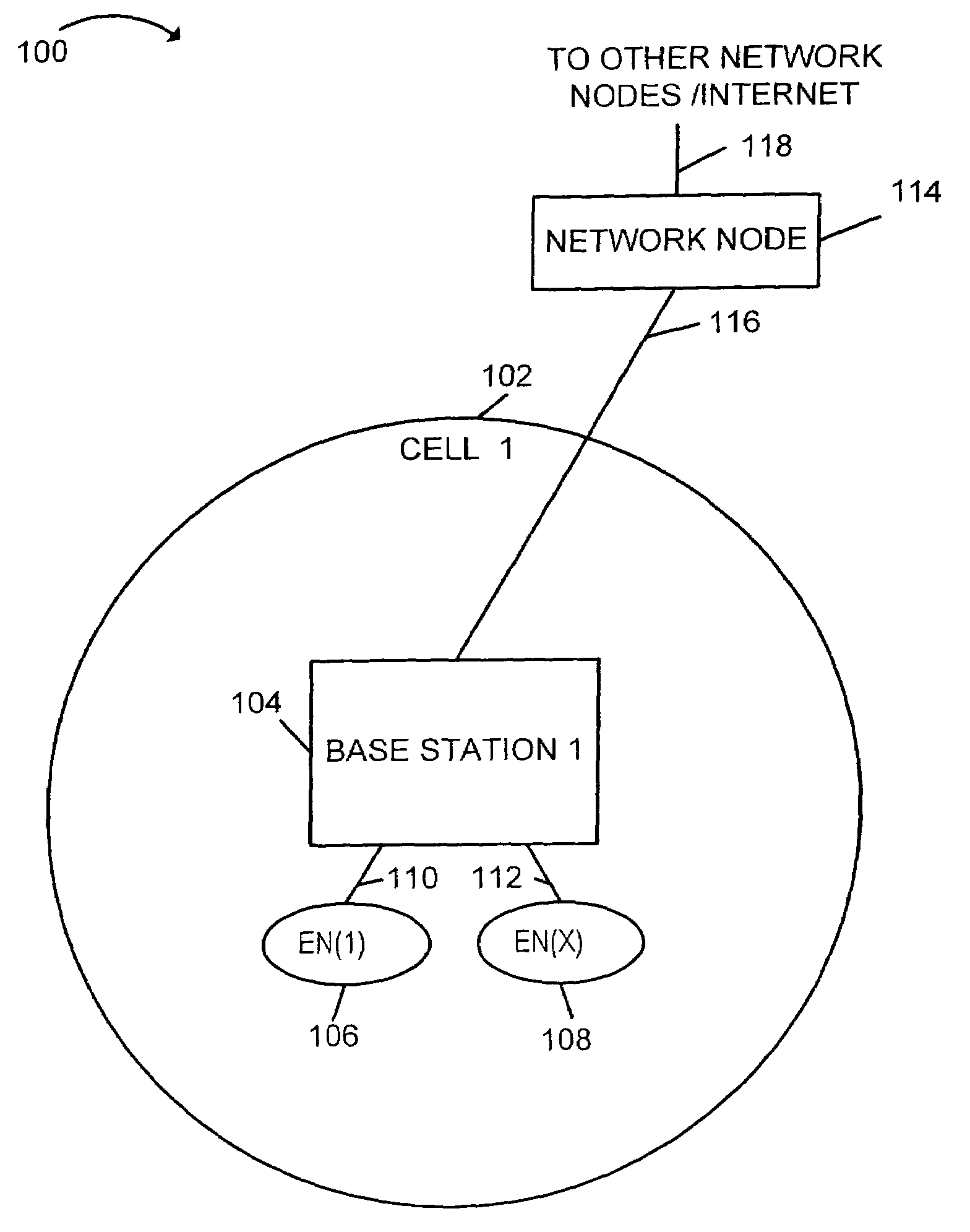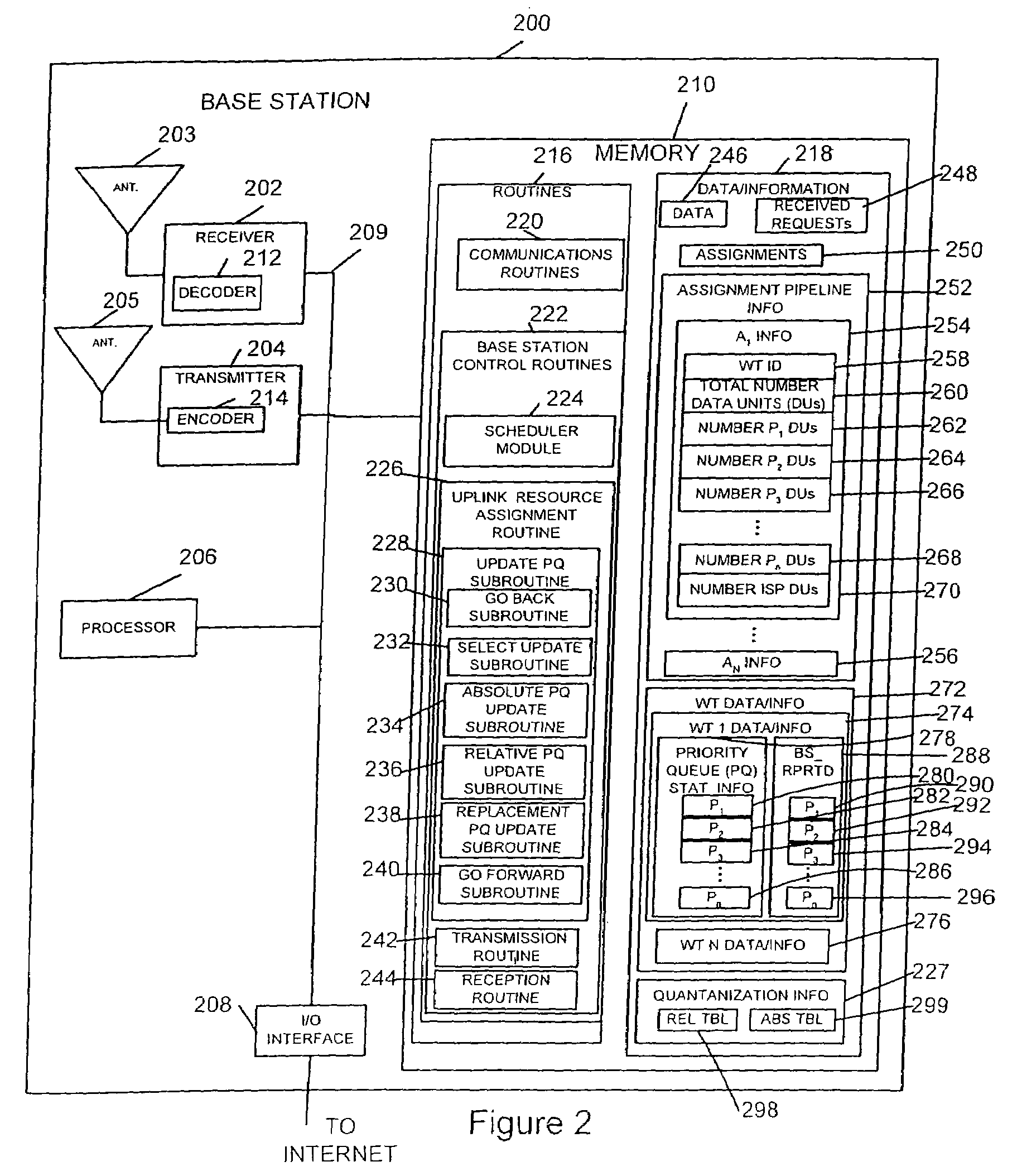[0033]The present invention is directed to methods and apparatus for making traffic channel resource allocation requests. Requests may include information such as the number of transmission units required and / or the priority level of data to be transmitted using the requested units. Requests may be of several types. Requests of different types are arranged in groups in some embodiments. Incremental, e.g., relative requests may be made within a group of request. However, groups of requests are interpreted in many embodiments independently, with absolute request values being used to reduce the propagation of errors in tracking request status from one group of requests to the next. Groups of requests including multiple requests may be transmitted on a periodic basis or according to some pre-selected schedule. In some embodiments, groups of requests are transmitted in time periods under 98 milli seconds (ms) in duration to ensure accurately and timely uplink status information.
[0034]In accordance with the invention, the requests transmitted in each group of requests (GOR) over time by a wireless terminal (WT), e.g., mobile node, end node or mobile station, can be interpreted by the receiving base station (BS) without knowledge of the requests made in another GOR. Within each GOR, in one exemplary embodiment, the BS can interpret the request made in the first (0th) request unit by itself. This is because the first request in each group of requests is transmitted in the exemplary embodiment as an absolute value which does not depend on previously transmitted requests. Subsequent requests in the group of requests may be transmitted as relative values, e.g., values which are to be interpreted as a function of some previously transmitted request value and / or as a function of assignment information which corresponds to grants of previous requests. A relative request value may be, e.g., a request for an incremental number of transmission data units corresponding to the priority level associated with the associated request. In the exemplary embodiment, the first time data units corresponding to a particular priority level are requested, the request is made using an absolute value. In some, but not all implementations, subsequent requests made for transmission units of the same priority level in the same GOR are communicated using relative values. In some implementations the number of relative request values in a GOR is more than the number of absolute request values thereby leading to efficient use of the limited request communications resource. The start of each GOR allows the BS to updates its counters, e.g., queue information, using absolute values and thereby correct for various errors which may accumulate due to the use of relative request values and / or the failure to receive all transmitted requests. All BS counters need not be reset at the start of each GOR. Thus, in the case of relative requests, the relative request values included in such requests are normally interpreted by the BS based on one or more of the requests made in preceding request units of the same group of requests.
[0036]In some embodiments, requests are formed based on the WT's actual Q-stats msQ. In addition to being based on msQ, a request can also be based on msBsQ, and / or preceding requests in the same group of requests. Relative request values are generated in this manner in some embodiments. Periodically and / or frequently requests are formed without basing them on msBsQ. The values used in such requests are normally absolute values, e.g., values which indicate a full actual count of the number of transmission data units desired for a particular priority level as opposed to an incremental number of desired data units, the number of data units desired beyond the number already requested. The use of absolute values facilitates quick synchronization between WT and BS understanding of Q-stats in case of the loss of requests or assignments due to channel errors.
[0039]Tracking bsQ at the WT (through the variable msBsQ at WT), and the ability to be able to report WT's traffic information (msQ) relative to msBsQ, gives the WT great flexibility in constructing uplink requests. In one embodiment, after reporting absolute traffic information about priority group A in one request, in the next request the WT can decide to report absolute traffic information about another priority group B instead of reporting relative traffic information about priority group A. Such flexibility may not available in a scheme where WT reports its absolute traffic information or its quantized version (based on msQ) without recourse to msBsQ. In another embodiment, the WT can split reporting of traffic information about a priority group into multiple requests in a way that adds robustness to the requests against channel errors. For example, 15 frames of priority group 3 can be reported as 8 frames in one request and 7 frames in the next request (instead of say 12 frames in one request and 3 frames in next request, or simply 15 frames in one request). This way, if the first request is lost the second can still provide a good idea of MS's traffic information. Again, this may not be possible with a scheme based solely on reporting absolute traffic information or its quantized version.
[0042]In some embodiments, a request can carry information regarding non-zero count (or its quantized version) of frames of a single stream priority, where this stream priority need not be the highest stream with non-zero frames. The count reported in such a case is an absolute count of the number of frames. Here, the WT has great flexibility in picking the priority that it chooses to report.
 Login to View More
Login to View More  Login to View More
Login to View More 


